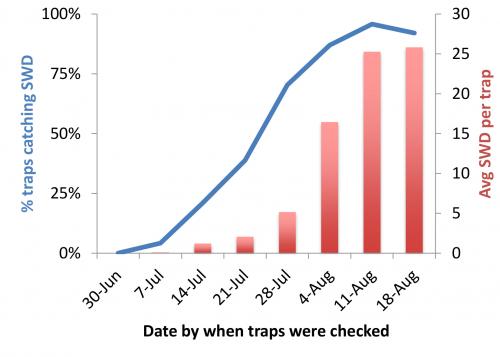Michigan spotted wing Drosophila report for August 18, 2015
High pressure from spotted wing Drosophila continues and some growers are still not aware this pest is a statewide problem. Fortunately, susceptible crops can be protected.
The summer increase of spotted wing Drosophila (SWD) continues with 92 percent of all of sites in the network reporting SWD in traps this week. The highest per trap average came from the west central region, but both southeast and southwest had high averages as well (see the first graph below). The total number of SWD caught this week was very similar to last week with 941 females and 1,977 males for a total of 2,918 captured in 104 traps out of the 113 traps.
The message to growers is the same as last week: Susceptible crops that are not being protected in all regions of the state are still at high risk from SWD infestation. It is essential to maintain fruit protection on ripe or ripening fruit that are susceptible to prevent larval infestation in fruit. Maintain coverage with an effective insecticide and do not stretch your spray intervals too far. Also, be sure to reapply after rain because otherwise the fruit will then be unprotected.
Reports continue to come in from growers who are apparently unaware this is a statewide problem in cherries, blueberries, raspberries and other thin-skinned fruit. If you have not been monitoring or actively managing for this pest because you think it is not there, it can almost be guaranteed this pest is in your fruit crop. Fruit that is softer than expected is a telltale sign. Consult Michigan State University’s Spotted Wing Drosophila website where there are crop recommendations posted for berry crops, or contact your local Michigan State University Extension fruit educator.
A salt test is strongly recommended prior to harvest to help determine whether protective measures are working or if your management program needs to be adjusted. For instructions on how to conduct a salt test, please refer to the July 28 SWD report.
For instructions on how to construct your own traps and use them for monitoring for SWD, please visit the MSU Spotted Wing Drosophila website. For specific recommendations about managing SWD in berry crops, please see “Increase of spotted wing Drosophila in berry crops.”
This is the 10th weekly report of the MSU Extension SWD monitoring network. Traps in the network are baited with Trece lures and placed near susceptible crops and wild hosts in each of the major fruit growing regions across the state. Commercial plantings include strawberries, blueberries, raspberries, grapes, tart and sweet cherries, peaches and plums. Wild hosts in the trapping network include autumn olives, black cherries, pin cherries, choke cherries, blackberries, honeysuckle, mulberries and wild grapes.

Average number of spotted wing drosophila flies caught in traps in four Michigan fruit production regions. This week: NW = 67 traps in Antrim, Benzie, Grand Traverse, Leelanau and Manistee sounties; SE = 7 traps across Ingham, Lenawee, Livingston, Monroe and Oakland; SW = 27 traps across Allegan, Berrien, Ottawa and Van Buren; and WC = 12 traps in Ionia, Kent and Oceana.

Average number of spotted wing drosophila (SWD) captured per trap (red bars) and the percentage of traps that captured any SWD (blue line) across the entire trapping network by week starting in June 30, 2015.



 Print
Print Email
Email




